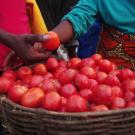This fact sheet describes and depicts the stages of maturity for orange chili, as well as information on quality, common defects, and harvesting. This document was created as part of the Horticulture Innovation Lab project focused on reducing postharvest loss in Rwanda.
Maturity indices
Orange chilies progress through eight stages of maturity. Initially the chili is completely green. Harvesting begins in the third stage when a tannish-yellow, pink, or red color shows on over 10% but not more than 30% of the chili surface. Chilies for drying should be harvested in the seventh stage, when less than 90% of the chili surface is covered by light orange.
Quality
In high quality orange chilies the orange color is evenly distributed and there are minimum defects. Chilies which display decay or insect damaged parts should be rejected.
Common quality defects include decay, insect damage, cracks, and sunburn. Decay is caused by microorganisms such as bacteria, yeasts and fungi that feed on the fruit and break it down. Insect damage may lead to the introduction of microorganisms. Cracks are a sign of insufficient mineral nutrients in the peel. Sunburn is a loss of pigmentation on the sun exposed side of the fruit.
Chilies Harvesting
Chilies should be harvested by hand or using scissors. During harvesting keep them in smooth and perforated containers. It is advisable to wear gloves while harvesting chilies.

